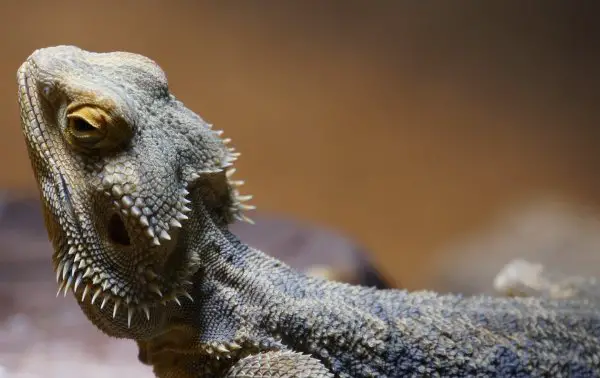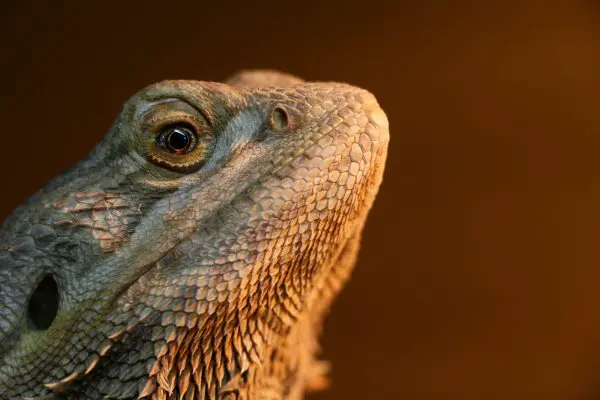Why Is My Bearded Dragon Chirping?
If you have noticed that your bearded dragon is chirping you may be wondering why and if you should be concerned…
Why Is My Bearded Dragon Chirping?
While it could be a ‘hiccup’, if you start hearing chirping at a regular pace, then this could be a warning sign of an upper respiratory infection. Bearded Dragons tend to communicate in body language and even some color changes as well. Head-bobbing, for instance, is a sign of dominance, while darkening of the beard occurs during mating or times of stress.
| Are these foods dangerous for your Beardie? | |
| Avacado? Click here to learn, from this guide, if this food is dangerous |  |
| Superworms? Click here to learn, from this guide, if this food is dangerous |  |
So, now you know. But, what is chirping exactly? Do they usually make this sound? How can you tell if your Beardie is happy? Keep reading for these answers, and much more.
What is a chirping sound?

A bearded dragon lizard raising its head.
‘Chirping’ is just the term commonly used, but it doesn’t really sound like a bird chirp at all. When you hear ‘chirping’ described for Bearded Dragons, it refers more to a clicking sound, followed by a rush of air inward, and while it can sometimes sound a little whistly, quite often you’ll mostly notice just the click.
As this can be a sign of an upper respiratory infection, a trip to the vet at this time is your best bet, and you might also consider if anything new has been added to their cage, the room that you are housing them in, or even the season – it could be allergies at play. The vet will be able to determine for sure.
As far as vocalization, though, that’s generally limited to hissing, and a chip that sounds rather like a click and a quick swallow of air could mean that your Beardy is having trouble breathing. An immediate visit to the vet is a good idea at this point
Do Bearded Dragons usually make noises?
Aside from hissing when you’ve made your Dragon cross, these reptiles are not very vocal at all. Instead, they communicate more with body language and with darkening and brightening their beards. Darkening of the beard usually indicates stress, although if your lizard is housed with a female, it is also associated with mating.
Other body languages such as puffing up for stress, head bobbing to show dominance, or ‘waving’ to show submission are the signs that you need to learn about and get used to in order to better know your Beardy.
About that hiss… while Bearded Dragons are pretty laid back, be careful about handling them when you hear a hiss – you might get a bite for your troubles!
How do I tell if my Bearded Dragon is happy?
The easiest way to tell if your Bearded Dragon likes you is if they are completely calm when you are handling them. Beardies that are unhappy tend to get a little aggressive, puffing up or darkening their beards, bobbing the heads at you (sorry, that’s not the music!), and if you get a hiss or even a bite then your Dragon simply doesn’t trust you yet.
It happens.
Be patient and work up to handling them slowly, feeding them the occasional treats, and speaking in a low, soothing voice to get them used to your sounds. Over time, once they realize that you aren’t going to harm them, your Bearded Dragon should start relaxing more and more in your presence.
Do Bearded Dragons like to be stroked?
This really depends on the individual Dragon and how well they have been socialized. If your Dragon has always been handled often, by you and perhaps by friends, then they are more used to seeing you and seeing people around and will generally not mind, or even enjoy a little bit of rubbing.
Not as much as a cat or dog, mind you, but many Bearded Dragons do seem to like being rubbed. Telltale signs include relaxed body language and best case, they might simply close their eyes and relax whenever you rub them.
Why is my Bearded Dragon purring?
Bearded Dragons do not purr as cats would. If you are hearing a guttural sort of clicking, then this is actually a red flag in regards to your Dragon’s health. This is known as ‘chirping’ and is often a sign of an upper respiratory infection. Simply put, your Dragon is having difficulty breathing.
Bring your Dragon in for an immediate vet visit in order to confirm this and if it is indeed a URI, then your veterinarian can prescribe some medication in order to help your sick Dragon to feel better.
Do Bearded Dragons like to be pet under the chin?

A brownish bearded dragon lizard staring.
You can pet your Dragon under the chin, but on the whole, MOST Beardies don’t like this very much. You also want to stay away from the mouth. Rubbing those cute little lizard lips is a great way to get a hiss or a surprise bite for your troubles, so you’ll want to stay away from your Dragon’s mouth.
You CAN, however, stroke the sides of the face or the top of your head, provided that your Dragon is relaxed and not showing any aggressive body language or darkening in color – a little trick that Dragons do, as they have chromatophores (color molecules, basically) in their skin that allow for brightening or darkening in color to reflect their moods and even for changing color as they grow
What is good body language from a beardie?
The best Beardie body language is simply a relaxed attitude towards being handled, petted, fed, or even simply approached by you. This shows that they trust you and don’t view you as a threat, as if they DID their body language would be quite clear on this.
Watch for signs that your Dragon is uneasy. While hissing and puffing up are the most obvious, you can also watch for head-bobbing as this is another sign that you are being viewed as a threat. In the case of hissing or head bobbing, be very careful.
Hissing is obvious, but the head bobbing means that your Dragon feels they are dominant over you.
This could mean that a bite is forthcoming, so either backdown or put on some gloves and try to calm them a bit with treats and tentative petting – though touching should stop quickly if it results in more stressed behavior.
Can you handle Bearded Dragons?
Certainly, just don’t rush things. Reptiles take a while sometimes to develop trust in you. From their perspective, the first impression is going to be that you are both enormous and probably a threat to them.
Over time, with feedings, light touches, and eventual handling, your Dragon will learn that you are not a threat and should grow more receptive to your attention.
Just be patient with the process. Sometimes it happens overnight, but more often trust must be built slowly and without trying to force the issue. Don’t worry, you’ll get there!
How often should I hold my Bearded Dragon?
The best thing to do is to start off slowly. Ideally, holding your Dragon for 10 to 15 minutes at a time and working up to longer periods is going to be the way to go. Be attentive to your surroundings so that external factors won’t accidentally break up the trust you are slowly building.
This means closing the door and warning family members or roommates not to burst in or knock loudly and if you have music playing, it is better to go with the soft kind, but even this can stress a Beardy out a little so silence is even better.
Set some times every day when you will hold your Dragon and add a few or more minutes every week until your Dragon is fully calm around you. By the time they’ve adjusted, you’ll have an excellent bond and you’ll have earned a good amount of your Dragon’s trust.